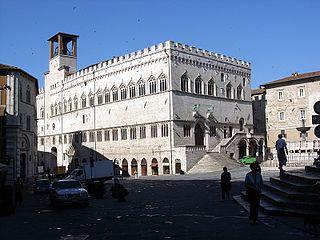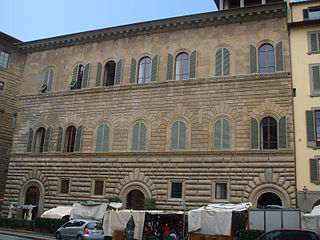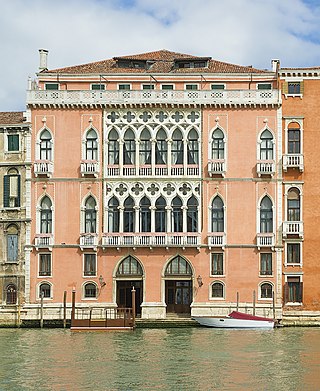
The Palazzo del Capitano del Popolo or Palazzo di Cante Gabrielli is a medieval palace in Gubbio, Italy. It is located in the San Martino's quartiere , near Porta Metauro, at the corner of via Gabrielli and via Capitano del Popolo.

The Palazzo del Capitano del Popolo or Palazzo di Cante Gabrielli is a medieval palace in Gubbio, Italy. It is located in the San Martino's quartiere , near Porta Metauro, at the corner of via Gabrielli and via Capitano del Popolo.
The building was erected towards the end of the 13th century by Cante de' Gabrielli (1260-1335), who was Signore or lord of Gubbio with the title of Captain of the People (capitano del popolo). The building was one of the city's first public buildings. [1] The palace, whose architect remains unknown, was used as both private residence and public office by Cante Gabrielli, and was built on land already belonging to his family. This area of the town was largely under the influence of the Gabrielli, as exemplified by the fact that other neighbouring constructions, including the towered family palace still visible along the eponymous street, belonged to them.
In the 14th century, the palace continued to serve as residence of the Captain of the People, until 1384 when the Dukes of Urbino seized Gubbio, the title was abolished and the building was sold. The palace saw several successive owners before the Ceccarelli family acquired it in the 19th century. On 7 December 1967, Alfio Ceccarelli (1920-2010) and Carlo Ceccarelli sold the property, [2] which was acquired by Dante Minelli and subsequently restored it in 1970. [1]
Together with the Palazzo dei Consoli and the Palazzo del Bargello in the same town, the palace is an examples of Umbria Gothic style, as later additions were removed by a restoration at the beginning of the 20th century. Its angled, monochromatic façade, built in the typical local grey limestone, is characterised by four ogival arches on the ground floor, four large ogival windows on the first floor and six smaller ogival windows on the second floor. Floors are marked by string courses running below the windows. The left part of the facade was not restored and still shows later alterations such as square windows and tampered arches.
Nowadays the palace hosts a museum dedicated to medieval torture practices and instruments (also known as Museo Cante Gabrielli. A white round stone on the ground in front of the building is believed to have served as one of the Umbrian altars described in the Iguvine Tablets.

Todi is a town and comune (municipality) of the province of Perugia in central Italy. It is perched on a tall two-crested hill overlooking the east bank of the river Tiber, commanding distant views in every direction. It was founded in antiquity by the Umbri, at the border with Etruria; the gens Ulpia of Roman emperor Trajan came from Todi.

Gubbio is an Italian town and comune in the far northeastern part of the Italian province of Perugia (Umbria). It is located on the lowest slope of Mt. Ingino, a small mountain of the Apennines.

Piazza dei Cavalieri is a landmark in Pisa, Italy, and the second main square of the city. This square was the political centre in medieval Pisa. After the middle of 16th century the square became the headquarters of the Order of the Knights of St. Stephen. Now it is a centre of education, being the main house of the Scuola Normale di Pisa, a higher learning institution part of the University.

The Palazzo dei Priori or comunale is one of the best examples in Italy of a public palace from the communal era. It is located in the central Piazza IV Novembre in Perugia, Umbria. It extends along Corso Vannucci up to Via Boncambi. It still houses part of the municipality, and, on the third floor, the Galleria Nazionale dell'Umbria. It takes its name from the Priori, the highest political authority governing the city in the medieval era.

Italian Gothic architecture (also called temperate Gothic architecture, has characteristics that distinguish it considerably from those of the place of origin of Gothic architecture, France, and from other European countries in which this language has spread.

The Palazzo San Giorgio or Palace of St. George is one of the most important and well-known historic buildings in Genoa. It currently houses the headquarters of the Port System Authority of the Western Ligurian Sea.

The Doge's Palace is a historical building in Genoa, northern Italy.

The Palazzo Comunale, also known as the Palazzo del Popolo of San Gimignano has been the seat of the civic authority in the comune since the 13th century. It is located on the Piazza del Duomo close to the Collegiate Church of the Assumption of the Blessed Virgin Mary. The building and Collegiate Church are at the heart of the medieval town, and are part of the UNESCO World Heritage Site of the "Historic Centre of San Gimignano".

Palazzo Gondi is a palace in Florence, Italy, located a block from Piazza della Signoria. It was built in 1490 under design by Giuliano da Sangallo, who was inspired by other major works of stately buildings in the city, such as Palazzo Medici and Palazzo Strozzi. Among the elements borrowed from these earlier works are the cube-shape set around a central courtyard, the ashlar sloping on each of three floors, and the arched windows.

Palazzo Pisani Moretta is a palace situated along the Grand Canal in Venice, Italy, between Palazzo Tiepolo and Palazzo Barbarigo della Terrazza.

The Palazzo dei Consoli is a Gothic architecture, civic building in the historic center of Gubbio, region of Umbria, Italy. Construction took place during 1332–1349 under design by Angelo da Orvieto; the palace was built on a large platform built against the hillside and looming over the town below.

The Palazzo Tolomei is an imposing, Gothic style urban palace, located on Via Banchi di Sopra in the present contrada of Civetta, Terzo di Camollia of the city of Siena, region of Tuscany, Italy.

The Museo Civico di Sansepolcro or Museo Comunale is the town or comune art gallery. It is housed in a series of linked palaces, including the medieval former Palazzo della Residenza, the Palazzo dei Conservatori del Popolo and the Palazzo del Capitano o Pretorio, located on Via Niccolò Aggiunti #65, near the center of Sansepolcro, formerly Borgo Santo Sepolcro, in the Province of Arezzo, region of Tuscany, Italy. The museum was founded in 1975.

Palazzo del Popolo, also called Palazzo del Priori or Podesta, is a Gothic architecture civic palace in Todi, region of Umbria, Italy.

The Castle of Carbonana is a medieval fortress located on a promontory overlooking the state road 219 that links Gubbio to Umbertide in the region of Umbria, Italy.

Castel Goffredo Town Hall and Loggia della Magnifica Comunità are located in Piazza Mazzini in Castel Goffredo, in the Province of Mantua (Italy). It is the seat of the municipality.

Palazzo Giustinian Pesaro is a Gothic palace located in Venice, Italy, in the Cannaregio district and overlooking the Grand Canal. The palazzo is situated between Ca' d'Oro and Palazzo Morosini Sagredo.

The Palazzo dei Priori is a Gothic-style monumental civic building in the center of the town of Volterra, located on the Piazza dei Priori, also known as Piazza Maggiore. The imposing 13th-century stone building once the office of appointed town magistrates, still has offices of the local commune, including the communal council, for Volterra, province of Pisa, region of Tuscany, Italy.

The Palazzo del Capitano del Popolo, also known as the Palazzo del Podesta is a late-Romanesque-Gothic architecture, late 13th-century civic palace located in Piazza del Popolo, in the historic center of Orvieto, region of Umbria, Italy. The palace now houses some municipal offices and the main hall is used for cultural events and meetings.

The Palazzo del Podesta, also known as Palazzo del Governatore, is a 13th-century civic palace located in Piazza del Plebiscito in central Viterbo, region of Lazio, Italy. It is attached and mainly accessible through the arch over Via Filippo Ascenzi connecting it to the larger Palazzo della Commune or Comunale.